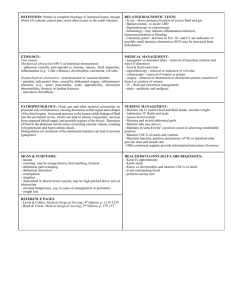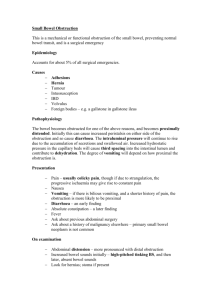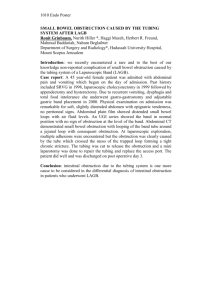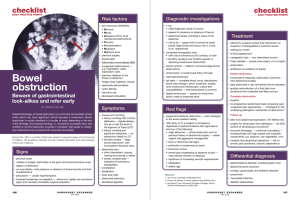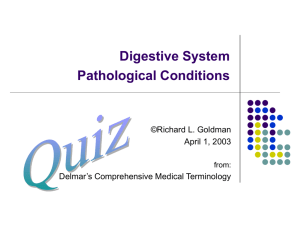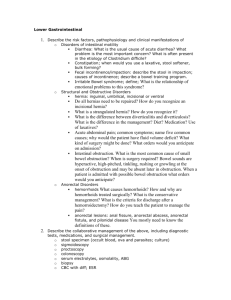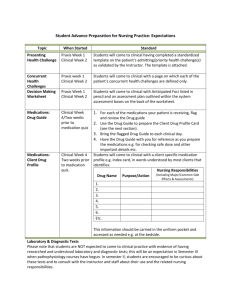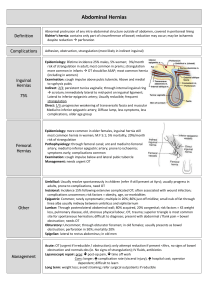Small Bowel Obstruction
advertisement
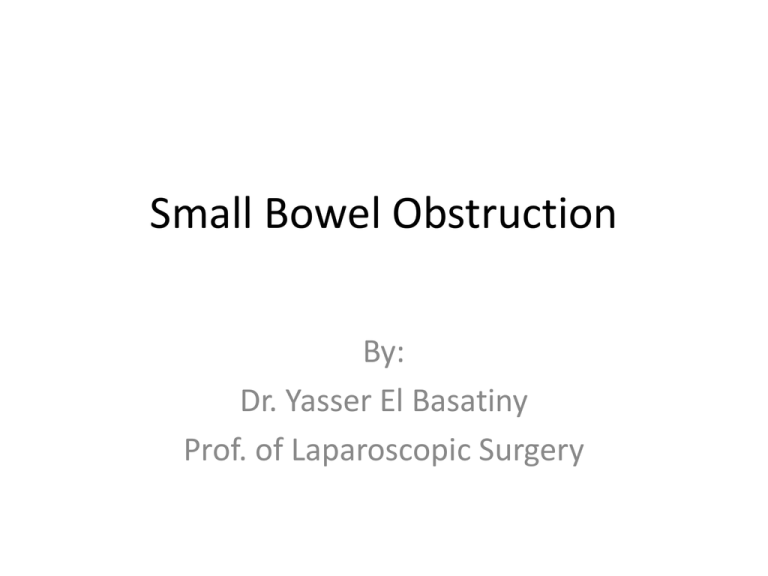
Small Bowel Obstruction By: Dr. Yasser El Basatiny Prof. of Laparoscopic Surgery Intestinal obstruction • • • • • Definition Etiology Pathogenesis Diagnosis Treatment of intestinal obstruction definition • When gastrointestinal luminal content is pathologically prevented from passing distally Etiology Causes of intestinal obstruction Dynamic Adynamic • Intraluminal Paralytic ilus Mesenteric vascular occlusion Pseudo obstruction Fecal impaction Foreign body Bezoars Gall stones • Intramural Stricture malignancy • Extramural Adhesions & bands Hernias (internal – external) Volvulous Intussception Causes according to age • Neonates: congenital atresia, volvulus neonatorum, anorectal malformation, mechonium ileus and hirshsprung’s disease • Infant: ileocecal intussusception, hirschsprung’s disease and strangulated hernia • Adult: adhesions, strangulated hernia • Elderly: colon carcinoma, adhesion and strangulated hernia. Pathogenesis • Simple obstruction: When the bowel occluded at a single point along the intestinal tract. • Closed loop obstruction: When segment of bowel is closed in two points along its proximal & distal end & trap the mesentery. • Strangulation: When blood supply to a closed loop segment of bowel becomes compromised leading to ischemia, necrosis and perforation. Pathophysiology • Early in the course of an obstruction, intestinal motility and contractile activity increase in an effort to propel luminal contents past the obstructing point. Later in the course of obstruction, the intestine becomes fatigued and dilates, with contractions becoming less frequent and less intense • As the bowel dilates, water and electrolytes accumulate both intraluminally and in the bowel wall itself. This massive third space fluid loss accounts for dehydration and hypovolemia. pathophysiology • The metabolic effects of fluid loss depend on the site and duration of the obstruction. With a proximal obstruction, dehydration may be accompanied by hypochloremia, hypokalemia, and metabolic alkalosis associated with increased vomiting. Distal obstruction of the small bowel may result in large quantities of intestinal fluid into the bowel; however, abnormalities in serum electrolytes are usually less dramatic. • Oliguria, azotemia, and hemoconcentration can accompany the dehydration. Hypotension and shock can ensue. Other consequences of bowel obstruction include increased intra abdominal pressure, decreased venous return, and elevation of the diaphragm, compromising ventilation. These factors can serve to further potentiate the effect of hypovolemia. pathophysiology • As the intraluminal pressure increases in the bowel, a decrease in mucosal blood flow can occur. These alterations are particularly noted in patients with a closed loop obstruction in which greater intraluminal pressure are attained. • A closed loop obstruction, (produced commonly by a twist of the bowel) can progress to arterial occlusion and ischemia if left untreated and may potentially lead to bowel perforation and peritonitis. • Bacteria translocating to mesenteric lymph nodes and even systemic organs. However, the overall importance of this bacterial translocation on the clinical course has not been entirely defined. Clinical picture • Cardinal symptoms Pain, distension, vomiting, absolute constipation • The nature of the presentation will be influenced by the site In high small bowel obstruction, vomiting occurs early and is profuse with rapid dehydration. Distension is minimal with little evidence of fluid levels on abdominal radiography In low small intestinal obstruction, pain is predominant with central distension. Vomiting is delayed. Multiple central fluid levels are seen in radiography In large bowel obstruction, distention is early and pronounced. Pain is mild and vomiting and dehydration are late. The proximal colon and caecum are distended on abdominal radiography Clinical picture • The nature of the presentation will also be influenced by whether the obstruction is: Acute , Chronic, Acute on chronic, Sub acute. Acute obstruction usually occurs in small bowel obstruction, with sudden onset of sever colicky central abdominal pain, distension and early vomiting and constipation. Chronic obstruction is usually seen in large bowel obstruction, with lower abdominal colic and absolute constipation followed by distension. Acute on chronic obstruction there is short history of distension and vomiting against a background of pain and constipation. Sub acute obstruction implies an incomplete obstruction. • Presentation will be further influenced by whether the obstruction is Simple: in which the blood supply is intact Strangulating, strangulated. History • Pain: crampy paroxysms 4-5 minute interval, less in distal obstruction, centered on the umbilicus in small bowel obstruction or lower abdominal in large bowel obstruction. • Sever persistent pain indicates strangulation. • Usually doesn't occur in paralytic ileus. • Nausia and vomiting: more common with a higher obstruction and may be the only symptoms in gastric outlet obstruction. • As obstruction progress the character of the vomitus alters from digested food to faeculent material, as a result of the presence of enteric bacterial overgrowth. History • In the small bowel the degree of distension is dependent on the site of the obstruction and is greater the more distal the lesion. Visible peristalsis may be present. Distension is delayed in colonic obstruction and may be minimal or absent in the presence of mesenteric vascular occlusion. • Constipation may be classified as absolute (neither faeces nor flatus passed) or relative (where only flatus passed). Absolute conistipation is a cardinal feature of complete intestinal obstruction. Some patients may pass flatus or faeces after the onset of obstruction as a result of evacuation of the distal bowel content. No constipation in: Richter’s hernia, gall stone obstruction, mesenteric vascular occlusion, pelvic abscess, partial obstruction (faecal impaction – colonic neoplasm) in which diarrhea may often occur Clinical picture • On Examination • General examination Tachycardia, hypotension, demonstrating the severe dehydration that is present. Fever suggests the possibility of strangulation. Clinical picture • Local abdominal examination • Inspection: distended abdomen, the degree of distension some what dependant on the level of obstruction. • Previous surgical scars should be noted. Early in the course of bowel obstruction, peristaltic waves can be observed, particularly in thin patients • Palpation: Mild abdominal tenderness may be present with or without a palpable mass; however localized tenderness, rebound and guarding suggest peritonitis and strangulation. • Incarcerated hernias should be rolled out in the groin, the femoral triangle and the obturaror foramin. • Percussion: • Auscultation: hyper active bowel sounds with audible rushes associated with vigorous peristalsis (borborygmi). Late in the obstructive course, minimal or no bowel sounds are noted. • Rectal examination: to assess intraluminal masses and to examine the stools for occult blood, which may be indication of malignancy, intussusception or infarction. Strangulation • Classic picture of strangulation include tachycardia, fever, leukocytosis and a constant non cramping abdominal pain. Tenderness with rigidity, shock with the cardinal signs of intestinal obstruction. • In cases of intestinal obstruction in which pain persists despite conservative management, even in absence of the above signs, strangulation should be considered. • When strangulation occurs in an external hernia, the lump is tense, tender and irreducible, there is no impulse on cough and it has recently increased in size. Strangulation pathology • The venous return is compromised before the arterial supply. The resultant increase in capillary pressure leads to local mural distension with loss of intravascular fluid and red blood cells intramurally and extraluminally. • Once the arterial supply is impaired, haemorrhagic infarction occurs. As the viability of the bowel is compromised there is marked translocation and systemic exposure to anaerobic organisms with their toxins. • The morbidity of intra-peritonial strangulation is far greater than with an external hernia, which has a smaller absorptive surface. Causes of strangulation • External: hernial orifices.. Adhesions and bands • Interrupted blood flow: volvulus, intussusceptions • Increased intraluminal pressure: closed loop obstruction • Primary: mesenteric infarction Closed loop obstruction • This occurs when the bowel is obstructed at both the proximal and distal points. • It is present in many cases of intestinal strangulation. Unlike cases of non strangulating obstruction, there is no early distension of the proximal intestine. When gangrene of the strangulated segment is imminent, retrograde thrombosis of the mesenteric veins result in distension on both sides of the strangulated segment. • A classic form of closed loop obstruction is seen in the presence of a malignant stricture of the right colon with a competent ileocaecal valve. The inability of the distended colon to decompress itself into the small bowel results in an increase in luminal pressure, which is greatest at the caecum, with subsequent impairment of blood supply. Unrelieved, this results in necrosis and perforation Investigations Plain x- ray of abdomen: erect and supine • The obstructed small bowel is characterized by straight segments that are generally central and lie transversally. No gas is seen in the colon. • The jejunum is characterized by its valvulae conniventes, which giving a concertina or ladder effect. • Ileum: the distal ileum has been described as featureless. • Caecum: a distended caecum is shown by a rounded gas shadow in the right iliac fossa. • Large bowel, except the caecum is shows haustrel folds, which, unlike valvulae conniventes are spaced irregularly, do not cross the whole diameter of the bowel and do not have indentations placed opposite one another Blood urea nitrogen and electrolytes Blood picture Ultrasonography CT scan Endoscopy Small bowel obstruction Multiple dilated small bowel loops are seen (white arrowheads). There is fecal material in the right and left colon (arrows). Air is seen in the rectum. The surgical staples indicate recent abdominal surgery (black arrowheads). Erect plain X-ray Treatment The treatment is urgent relief of obstruction after preparation • Preoperative preparation (fluid and electrolyte replacement, antibiotics and tube decompression) • Operation: exploration • Immediate operation indicated in peritonitis, incarcerated hernia, suspected or confirmed strangulation, sigmoid volvoulus with systemic toxicity or peritoneal irritation, small bowel volvulus, colonic volvoulus above sigmoid. • Conservative (with exeption) • Indication : adhesive. Ileocaecal intussusception. Sigmoid volvoulus. Feacal impaction. • Reassess patient every 4 hours. Look for change in pain, abdominal findings, and volume and character of nasogastric aspirate. Repeat abdominal x- ray, and look for change in gas distribution, and free intraperitoneal air. • Classify patient’s condition as improved, unchanged or worse. • Decide whether operative treatment is necessary and if so, whether it should be done on urgent or elective basis. • Urgent operation: indications include: lack of response to 24 – 48 hrs. of nonoperative therapy (increasing abdominal pain, distension or tenderness; NG aspirate changing from nonfeculent to feculent. Treatment Fluid resuscitation and antibiotics • Patients with intestinal obstruction are usually dehydrated and depleted of sodium, chloride, and potassium, requiring aggressive intravenous replacement with an isotonic saline solution such as lactated ringer’s • Urine output: should be monitored by the placement of foley’s catheter. • After the patient has formed adequate urine, potassium chloride should be added to the infusion if needed. Serial electrolyte measurements, as well as hematocrit and white blood cell count are performed to assess the adequacy of fluid repletion. • Central venous line: may be needed especially in elderly as the patient may require large amount of fluid • Broad spectrum antibiotics: are given prophylactically by some surgeons based on the reported findings of bacterial translocation, and as preoperative preparation. Treatment • Tube decompression and follow up • Nasogastric suction empty the stomach, reducing the risk of pulmonary aspiration and reduce further intestinal distension • Simple intestinal obstruction can be treated conservatively with resuscitation and nasogastric tube suction, resolution of symptoms and discharge without surgery have been reported in 60% to 85% of patients with an adhesive simple intestinal obstruction. • Initial conservative treatment for simple intestinal obstruction with close observation in case of clinical deterioration of the patient or increasing distension on repeated radiographes require operative intervention. Operative managment • Incarcerated hernia: reduction and repair Mid line exploration: (under general anesthesia) • Release of adhesions or fibrous band • Untwisting volvulus (viable bowel) • Resection anastomosis (gangrenous bowel, intestinal tumor or pathological stricture) • Reduction of Intussusception • Proximal ileostomy or colostomy. Operative management Define the obstructed point operatively: • Follow the distended bowel distally till find the collapsed intestine and define the lesion. Determine bowel viability: • By color, motility and arterial pulsations. if viability is questionable the bowel segment released and covered by sponge soaked with normal saline for 15 to 20 min. then revaluate Enterotomy and extraction of the stone. Septic peritonitis ileostomy Intestinal anastomosis Intussusception Adynamic • Paralytic ileus • Mesenteric vascular occlusion • Pseudo intestinal obstruction Paralytic ileus Causes of ileus • Post laparotomy • Metabolic and electrolyte derangements: hypokalemia, hyponatremia, hypomagnesaemia, uremia, diabetic coma • Drugs: opiates, psychotropic agents, anti cholinergic agents • Intra abdominal inflammation & sepsis • Retroperitoneal hemorrhage or sepsis • Intestinal ischemia • Systemic sepsis Paralytic ileus • Abdominal distension without colicky pain, may be nausea and vomiting • Plain X ray: distended small and large bowel Treatment: • Supportive with nasogastric suction and intravenous fluid • Correct the underlying condition, treatment of sepsis, correct metabolic or electrolyte abnormalities, stop drugs that produce ileus • Colonoscopy to decompress the colon. Mesenteric ischemia Mesenteric vascular disease classified as: • Acute (with or without occlusion) • Venous • Chronic arterial • Sources of embolisation: left atrium in fibrillation, mural myocardial infarction, atheromatous plaque from an aortic aneurysm and mitral valve vegetation. • Primary arterial thrombosis: in atherosclerosis and thromboangitis obliterans. • Venous thrombosis: portal hypertension, portal pyaemia and sickle cell disease. Mesenteric ischemia Pathology: • hemorrhagic infarction, the intestine and it’s mesentery become swollen and edematous, blood stained fluid exudes into the peritoneal cavity and bowel lumen. Clinical picture: • Sudden onset of sever abdominal pain in patient with atrial fibrillation or atherosclerosis. The pain is central • Persistent vomiting, bleeding per rectum (altered blood) • Hypovolemic shock. Investigation: • Profound neutrophil leucocytosis • Plain X ray thickened small intestine with no gas. • Angiography Mesenteric ischemia Treatment: • Full resuscitation • Embolectomy • Revascularization in early embolic cases • Resection of all affected bowel, early post operative anti coagulation • In massive resection, patient may need intravenous alimentation or consider small bowel transplantation. Pseudo obstruction Factors associated with pseudo obstruction • Idiopathic • Metabolic: diabetes, intermittent porphyria, acute hypokalaemia, uremia, myxodema • Sever trauma: especially to lumber spine and pelvis • Shock • Burns • Myocardial infarction • Stroke • Septicemia • Retroperitoneal irritation by: blood, urine, enzymes (pancreatitis), tumors. • Drugs: tricyclic antidepressants, phenothiazines, laxatives Thank you
